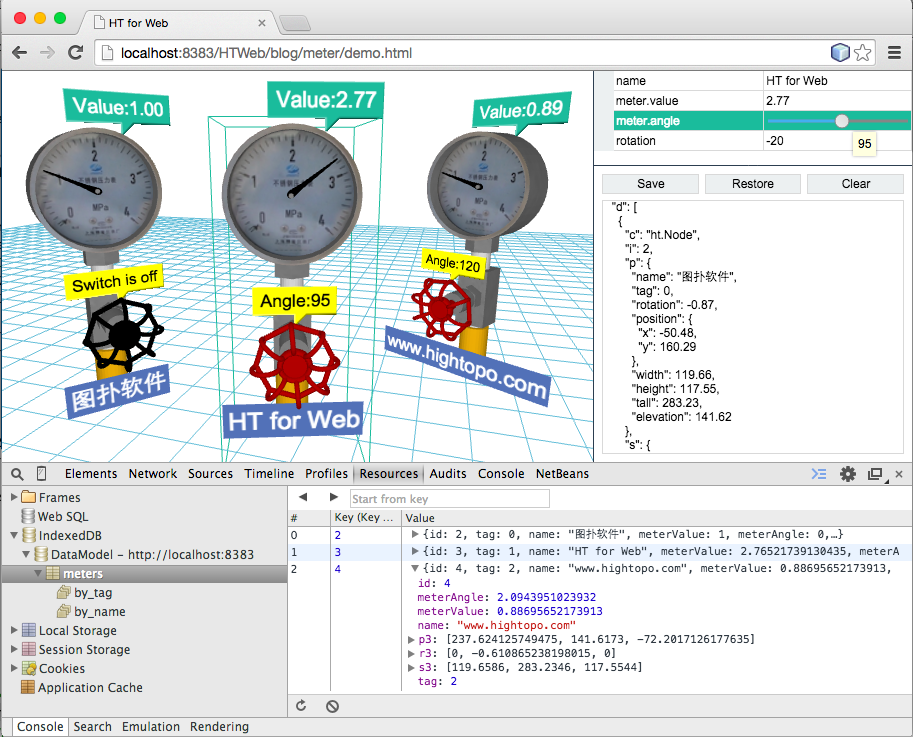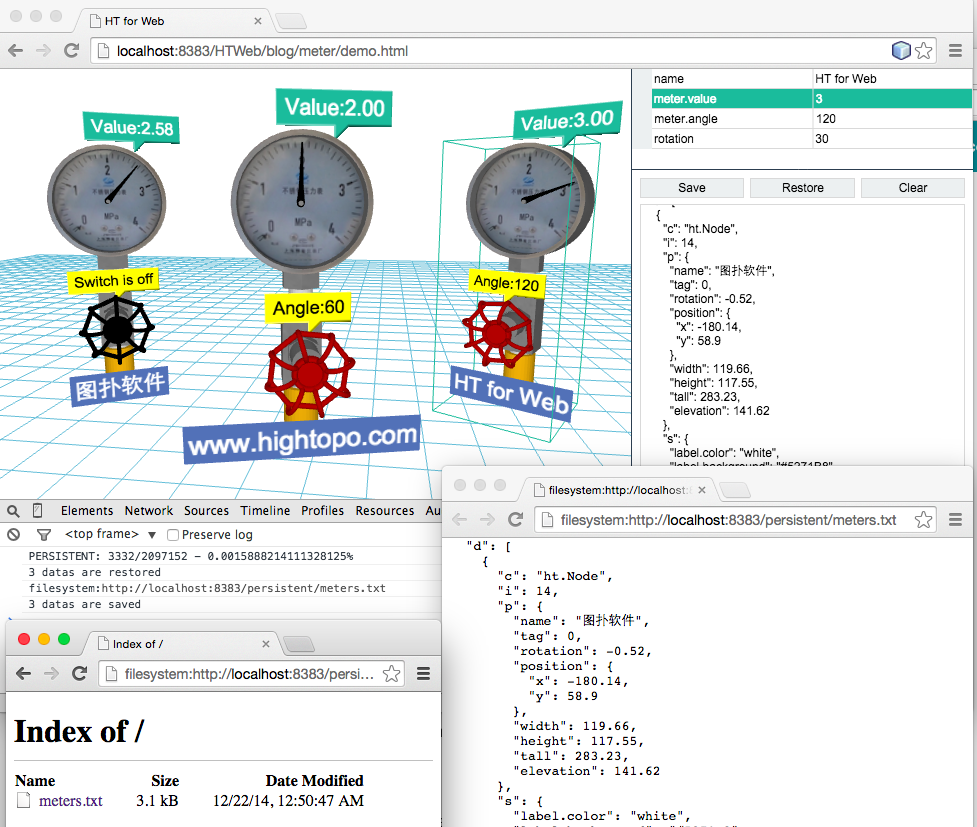最近折腾HTML5游戏需要离线存储功能,便把目前可用的几种HTML5存储方式研究了下,基于HT for Web写了个综合的实例,分别利用了Cookie、WebStorage、IndexedDB以及FileSystem四种本地离线存储方式,对燃气监控系统的表计位置、朝向、开关以及表值等信息做了CURD的存取操作。
HTML5的存储还有一种Web SQL Database方式,虽然还有浏览器支持,是唯一的关系数据库结构的存储,但W3C以及停止对其的维护和发展,所以这里我们也不再对其进行介绍:Beware. This specification is no longer in active maintenance and the Web Applications Working Group does not intend to maintain it further.
整个示例主要就是将HT for Web的DataModel数据模型信息进行序列化和反序列化,这个过程很简单通过dataModel.serialize()将模型序列化成JSON字符串,通过dataModel.deserialize(jsonString)将JSON字符串内存反序列化出模型信息,而存储主要就是主要就是针对JSON字符串进行操作。
先介绍最简单的存储方式LocalStorage,代码如下,几乎不用介绍就是Key-Value的简单键值对存储结构,Web Storage除了localStorage的持久性存储外,还有针对本次回话的sessionStorage方式,一般情况下localStorage较为常用,更多可参考 http://www.w3.org/TR/webstorage/
function save(dataModel){ var value = dataModel.serialize(); window.localStorage['DataModel'] = value; window.localStorage['DataCount'] = dataModel.size(); console.log(dataModel.size() + ' datas are saved'); return value; } function restore(dataModel){ var value = window.localStorage['DataModel']; if(value){ dataModel.deserialize(value); console.log(window.localStorage['DataCount'] + ' datas are restored'); return value; } return ''; } function clear(){ if(window.localStorage['DataModel']){ console.log(window.localStorage['DataCount'] + ' datas are cleared'); delete window.localStorage['DataModel']; delete window.localStorage['DataCount']; } }
最古老的存储方式为Cookie,本例中我只能保存一个图元的信息,这种存储方式存储内容很有限,只适合做简单信息存储,存取接口设计得极其反人类,为了介绍HTML5存储方案的完整性我顺便把他给列上:
function getCookieValue(name) { if (document.cookie.length > 0) { var start = document.cookie.indexOf(name + "="); if (start !== -1) { start = start + name.length + 1; var end = document.cookie.indexOf(";", start); if (end === -1){ end = document.cookie.length; } return unescape(document.cookie.substring(start, end)); } } return ''; } function save(dataModel) { var value = dataModel.serialize(); document.cookie = 'DataModel=' + escape(value); document.cookie = 'DataCount=' + dataModel.size(); console.log(dataModel.size() + ' datas are saved'); return value; } function restore(dataModel){ var value = getCookieValue('DataModel'); if(value){ dataModel.deserialize(value); console.log(getCookieValue('DataCount') + ' datas are restored'); return value; } return ''; } function clear() { if(getCookieValue('DataModel')){ console.log(getCookieValue('DataCount') + ' datas are cleared'); document.cookie = "DataModel=; expires=Thu, 01 Jan 1970 00:00:00 UTC"; document.cookie = "DataCount=; expires=Thu, 01 Jan 1970 00:00:00 UTC"; } }
如今比较实用强大的存储方式为Indexed Database API,IndexedDB可以存储结构对象,可构建key和index的索引方式查找,目前各浏览器的已经逐渐支持IndexedDB的存储方式,其使用代码如下,需注意IndexedDB的很多操作接口类似NodeJS的异步回调方式,特别是查询时连cursor的continue都是异步再次回调onsuccess函数的操作方式,因此和NodeJS一样使用上不如同步的代码容易。
request = indexedDB.open("DataModel");
request.onupgradeneeded = function() {
db = request.result;
var store = db.createObjectStore("meters", {keyPath: "id"});
store.createIndex("by_tag", "tag", {unique: true});
store.createIndex("by_name", "name");
};
request.onsuccess = function() {
db = request.result;
};
function save(dataModel){
var tx = db.transaction("meters", "readwrite");
var store = tx.objectStore("meters");
dataModel.each(function(data){
store.put({
id: data.getId(),
tag: data.getTag(),
name: data.getName(),
meterValue: data.a('meter.value'),
meterAngle: data.a('meter.angle'),
p3: data.p3(),
r3: data.r3(),
s3: data.s3()
});
});
tx.oncomplete = function() {
console.log(dataModel.size() + ' datas are saved');
};
return dataModel.serialize();
}
function restore(dataModel){
var tx = db.transaction("meters", "readonly");
var store = tx.objectStore("meters");
var req = store.openCursor();
var nodes = [];
req.onsuccess = function() {
var res = req.result;
if(res){
var value = res.value;
var node = createNode();
node.setId(value.id);
node.setTag(value.tag);
node.setName(value.name);
node.a({
'meter.value': value.meterValue,
'meter.angle': value.meterAngle
});
node.p3(value.p3);
node.r3(value.r3);
node.s3(value.s3);
nodes.push(node);
res.continue();
}else{
if(nodes.length){
dataModel.clear();
nodes.forEach(function(node){
dataModel.add(node);
});
console.log(dataModel.size() + ' datas are restored');
}
}
};
return '';
}
function clear(){
var tx = db.transaction("meters", "readwrite");
var store = tx.objectStore("meters");
var req = store.openCursor();
var count = 0;
req.onsuccess = function(event) {
var res = event.target.result;
if(res){
store.delete(res.value.id);
res.continue();
count++;
}else{
console.log(count + ' datas are cleared');
}
};
}
最后是FileSystem API相当于操作本地文件的存储方式,目前支持浏览器不多,其接口标准也在发展制定变化中,例如在我写这个代码时大部分文献使用的webkitStorageInfo已被navigator.webkitPersistentStorage和navigator.webkitTemporaryStorage替代,存储的文件可通过filesystem:http://www.hightopo.com/persistent/meters.txt’的URL方式在chrome浏览器中查找到,甚至可通过filesystem:http://www.hightopo.com/persistent/类似目录的访问,因此也可以动态生成图片到本地文件,然后通过filesystem:http:***的URL方式直接赋值给img的html元素的src访问,因此本地存储打开了一扇新的门,相信以后会冒出更多稀奇古怪的奇葩应用。
navigator.webkitPersistentStorage.queryUsageAndQuota(function (usage, quota) { console.log('PERSISTENT: ' + usage + '/' + quota + ' - ' + usage / quota + '%'); } ); navigator.webkitPersistentStorage.requestQuota(2 * 1024 * 1024, function (grantedBytes) { window.webkitRequestFileSystem(window.PERSISTENT, grantedBytes, function (fs) { window.fs = fs; }); } ); function save(dataModel) { var value = dataModel.serialize(); fs.root.getFile('meters.txt', {create: true}, function (fileEntry) { console.log(fileEntry.toURL()); fileEntry.createWriter(function (fileWriter) { fileWriter.onwriteend = function () { console.log(dataModel.size() + ' datas are saved'); }; var blob = new Blob([value], {type: 'text/plain'}); fileWriter.write(blob); }); }); return value; } function restore(dataModel) { fs.root.getFile('meters.txt', {}, function (fileEntry) { fileEntry.file(function (file) { var reader = new FileReader(); reader.onloadend = function (e) { dataModel.clear(); dataModel.deserialize(reader.result); console.log(dataModel.size() + ' datas are restored'); }; reader.readAsText(file); }); }); return ''; } function clear() { fs.root.getFile('meters.txt', {create: false}, function(fileEntry) { fileEntry.remove(function() { console.log(fileEntry.toURL() + ' is removed'); }); }); }
Browser-Side的存储方式还在快速的发展中,其实除了以上几种外还有Application Cache,相信将来还会有新秀出现,虽然“云”是大趋势,但客户端并非要走极端的“瘦”方案,这么多年冒出了这么多客户端存储方式,说明让客户端更强大的市场需求是强烈的,当然目前动荡阶段苦逼的是客户端程序员,除了要适配Mouse和Touch,还要适配各种屏,如今还得考虑适配各种存储,希望本文能在大家选型客户端存储方案时有点帮助,最后上段基于HT for Web操作HTML5存储示例的视频效果:http://v.youku.com/v_show/id_XODUzODU2MTY0.html

